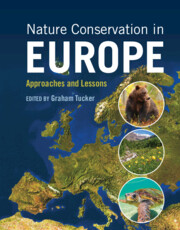Book contents
- Nature Conservation in Europe
- Nature Conservation in Europe
- Copyright page
- Dedication
- Contents
- Contributors
- Preface
- Acknowledgements
- Glossary, Abbreviations and Country Codes
- Chapter 1 Introduction: Aims, Scope, Structure and Key Information Sources
- Chapter 2 Europe’s Nature and Conservation Needs
- Chapter 3 The International Drivers of Nature Conservation, Their Objectives and Impacts on Nature Conservation Policies and Actions in Europe
- Chapter 4 Nature Conservation Policy, Legislation and Funding in the EU
- Chapter 5 Conclusions, Lessons Learnt and Implications for the Future
- Chapter 6 Austria
- Chapter 7 Belgium
- Chapter 8 Republic of Bulgaria
- Chapter 9 Republic of Croatia
- Chapter 10 Cyprus
- Chapter 11 The Czech Republic
- Chapter 12 Denmark
- Chapter 13 Estonia
- Chapter 14 Finland
- Chapter 15 France
- Chapter 16 Germany
- Chapter 17 Greece
- Chapter 18 Hungary
- Chapter 19 Ireland
- Chapter 20 Italy
- Chapter 21 Latvia
- Chapter 22 Lithuania
- Chapter 23 The Netherlands
- Chapter 24 Poland
- Chapter 25 Portugal
- Chapter 26 Romania
- Chapter 27 Slovakia
- Chapter 28 Slovenia
- Chapter 29 Spain
- Chapter 30 Sweden
- Chapter 31 United Kingdom
- Appendix Habitats Directive Annex I Habitat Types Referred to in This Book
- Index
- References
Chapter 2 - Europe’s Nature and Conservation Needs
Published online by Cambridge University Press: 11 May 2023
- Nature Conservation in Europe
- Nature Conservation in Europe
- Copyright page
- Dedication
- Contents
- Contributors
- Preface
- Acknowledgements
- Glossary, Abbreviations and Country Codes
- Chapter 1 Introduction: Aims, Scope, Structure and Key Information Sources
- Chapter 2 Europe’s Nature and Conservation Needs
- Chapter 3 The International Drivers of Nature Conservation, Their Objectives and Impacts on Nature Conservation Policies and Actions in Europe
- Chapter 4 Nature Conservation Policy, Legislation and Funding in the EU
- Chapter 5 Conclusions, Lessons Learnt and Implications for the Future
- Chapter 6 Austria
- Chapter 7 Belgium
- Chapter 8 Republic of Bulgaria
- Chapter 9 Republic of Croatia
- Chapter 10 Cyprus
- Chapter 11 The Czech Republic
- Chapter 12 Denmark
- Chapter 13 Estonia
- Chapter 14 Finland
- Chapter 15 France
- Chapter 16 Germany
- Chapter 17 Greece
- Chapter 18 Hungary
- Chapter 19 Ireland
- Chapter 20 Italy
- Chapter 21 Latvia
- Chapter 22 Lithuania
- Chapter 23 The Netherlands
- Chapter 24 Poland
- Chapter 25 Portugal
- Chapter 26 Romania
- Chapter 27 Slovakia
- Chapter 28 Slovenia
- Chapter 29 Spain
- Chapter 30 Sweden
- Chapter 31 United Kingdom
- Appendix Habitats Directive Annex I Habitat Types Referred to in This Book
- Index
- References
Summary
To provide context for the later chapters and analysis, the chapter outlines the key characteristics of Europe’s environment and nature, and the effects of human actions on it. It firstly describes the biophysical geography and natural history of Europe, including the legacy of the last Ice Age, and the current characteristics of the biogeographical regions and marine regions. It then summarises the main impacts of human activities on biodiversity in Europe, starting with early agriculture and forest clearances that created seminatural ecosystems and cultural landscapes, followed by the profound impacts of the industrial and agricultural revolutions, and more recent changes in land- and sea-use and resulting pressures over the last forty years. Other key pressures are also identified, including in relation to forestry, water and air pollution, fisheries, invasive alien species and climate change. The chapter concludes with an outline of Europe’s remaining biodiversity, identifying hotspots, and the implications for nature conservation approaches and priorities.
Keywords
- Type
- Chapter
- Information
- Nature Conservation in EuropeApproaches and Lessons, pp. 13 - 40Publisher: Cambridge University PressPrint publication year: 2023



